概率统计课件【英文】
- 格式:ppt
- 大小:106.00 KB
- 文档页数:17



Chapter 4 Mathematical Expectation4.1 Mean of Random Variables4.2 Variance and Covariance4.3 Means and Variances of LinearCombinations of Random variables4.4 Chebyshev’s Theorem13Definition 4.1 Let X be a random variable with probability distribution f(x).The mean or expected value of X isif X is discrete, andif X is continuous.Remark:The mean of a random variable X can be thought of as a measure of the “center of location”in the sense that it indicates where the “center”of the density line. xx xf X E )()( dx x xf X E)()(4Example 4.1, page 89The probability distribution of a random variable X is given byx =0,1,2,3.f(0)=1/35 f(1)=12/35 f(2)=18/35 f(3)=4/3537334)(x x x f 71235435183512351))(3())(2())(1())(0(5ExampleThe probability distribution of a random variable X is given byelsewherex e x f x 00)( 0)(dx e x X E x 00dx e xe xx 1 0 ( )6Example 4.2, page 90In a gambling game a man is paid $5 if he gets all heads or all tails when three coins are tossed, and he will pay out $3 if either one or two heads show. What is his expected gain?Let Y be the amount of gain per bet. The possible values are 5 and –3 dollars.Let X be the number of heads that occur in tossing three coins. The possible values of X are 0, 1, 2, and 3.Solution:P(Y = 5) = P(X = 0 or X = 3) = 1/8 + 1/8 = ¼P(Y = -3) = P(X =1 or X = 2) = 6/8 = ¾= (5)(1/4) + (-3)(3/4) = –1Interpretation : Over the long run, the gambler will, on average, lose $1 per bet. Most likely, the more the gambler plays the games, the more he would lose.7Notice that in the preceding example, there are two random variables, X and Y ; and Y is a function of X , for example if we letE(Y) = E(g(X))= (5)P(Y = 5) + (-3)P(Y = -3)= (5)[P(X = 0) + P(X = 3)] + (-3)[P(X = 1) + P(X = 2)]= (5)P(X = 0) + (5)P(X = 3) + (-3)P(X = 1) + (-3)P(X = 2) = g(0)P(X = 0) + g(3)P(X = 3) + g(1)P(X = 1) + g(2)P(X = 2)= 2,133,05)(X X X g Y x x f x g )()(8Theorem 4.1 Let X be a random variable with probability distribution f(x). The mean or expected value of random variable g(X)isif X is discrete, andif X is continuous.xX g x f x g X g E )()()]([)(dxx f x g X g E X g )()()]([)(9ExampleLet X denote the length in minutes of a long-distance telephone conversation. Assume that the density for X is given byFind E(X) and E(2X+3)Solution:E(X )= = = 10 E(2X+3)= = 2(10) + 3 = 23 .0)(10/101x e x f x dx e x x 10/0101)32( dxx f x )(dx e x x 10/010110Definition 4.2 Let X and Y be random variables with joint probability distribution f(x, y).The mean or expected value of the random variable g(X, Y)isif X and Y are discrete, andif X and Y are continuous. ),(),(),(),()],([y x Y X g y x f y x g Y X g E dydx y x f y x g Y X g E Y X g),(),()],([),( Extension11ExampleExample:Suppose two dice are rolled, one red and one white. Let X be the number on the top face of the red die, and Y be the number on the top face of the white one. Find E(X+Y).E[X + Y]= == ==3.5 + 3.5 = 7 ),(),()(y x y Y x X P y x 6161),()(x y y Y x X P y x 61616161),(),(x y x y y Y x X yP y Y x X xP 61616161)36/1()36/1(x y x y y x12Example 4.7, page 93. Find E[Y/X]for the densitySolution:= = elsewhere ,0 2020 ,16),(33 y , x y x y x f dydx y x f y x g Y X g E Y X g),(),()],([),( dy dx y x x y 20332016dy dx y x 2042201613In generalIf X and Y are two random variables, f(x, y)is thejoint density function, then:E(X)= = (discrete case) E(X)= (continuous case)E(Y)= = (discrete case)E(Y)= (continuous case)g(x)and h(y)are marginal probability distributions of X and Y , respectively. x y y x xf ),( xx xg )( dxx xg dxdy y x xf )(),( y x y x yf ),( y y yh )( dyy yh dxdy y x yf )(),(。
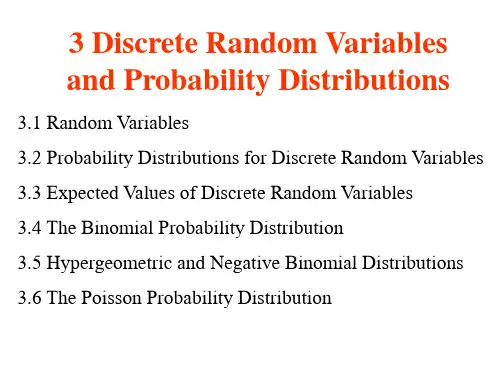
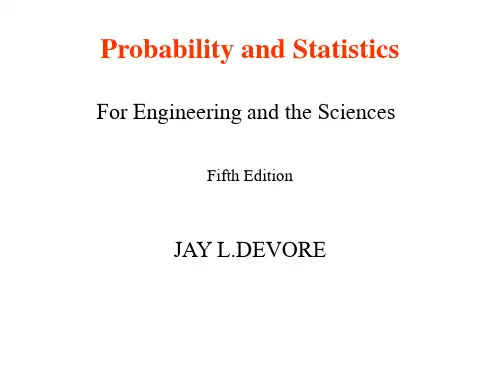


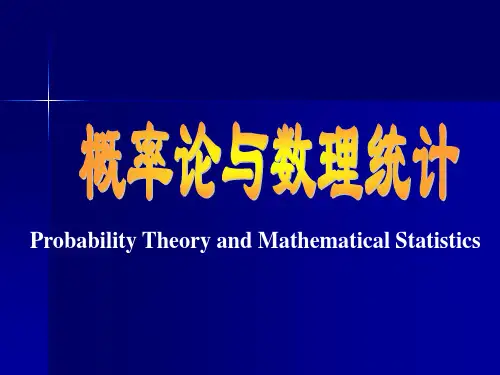
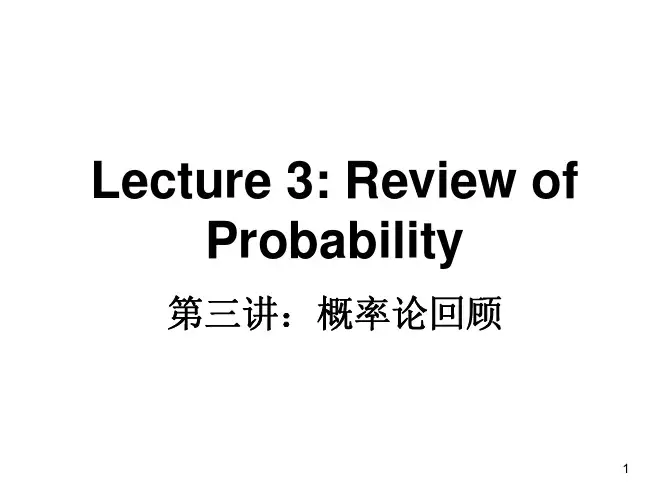

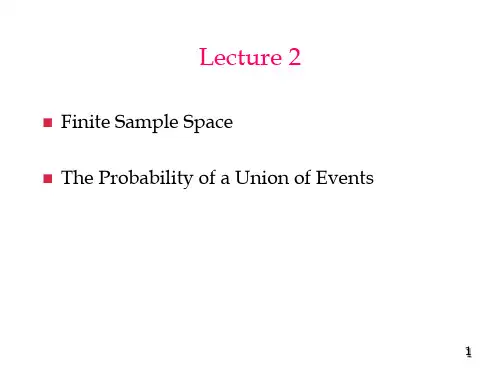
Topics (If time permits)1.Overview (Ch 1)2.Introduction to Probability (Ch 2 –Ch 7)3.From Probability to Inference : SamplingDistributions and Data Descriptions (Ch 8) 4.Estimation Process(Ch 9): One -and Two -Sample Point and Interval Estimate of aPopulation ParameterEvaluationThere will be weekly assignments:Assign on Wednesday Morning(Thursday Morning),while return on Monday Morning(Tuesday Afternoon)!The final grade of a student will be given based on his or her scores on the assignments(20%) and the final exam (80%).Correct use of language is one of the criteria included in the evaluation of all written work.IntroductionWhy Study Statistics and Probability?What Is Statistics?What is Probability?What Is the Role of Probability in Statistics?Happening i n Real Life1.Two football teams A and B have matchesin two sessions with score 4:1 and 5:0. Ifthey both met each other tomorrow, whichone could win?2.Two students promise to meet at the gate ofcampus library. The one who arrives firstwill wait the other for 15 minutes and willleave if waiting time span is bigger than 15 minutes. Will they meet successfully then?Happening i n Real Life3. Two students may have the same birthday ina class. What is the possibility ? This must happen for a class with a big enoughnumber.1-3*10-950.990.970.890.710.41905550403020Happening i n Real Life4. I can pass “the probability course”with theassurance of 80 percent.5. It is said that he has not fallen in love for fouryears in HUST. Right! Some boys complain: “Almost all of girls put their hears intobooks, not boys!”Right?6. It is reported that Chinese Yuan’s value isincreasing, while the value for Americandollar is decreasing more and more.Why Study Statistics and Probability •Statistics and probability is now an important part of everyday life, unavoidable and comes up in almost every walk of life.•Understanding the core ideas behind statistics and probability is crucial to your success in modern world.•By learning statistics and probability, you gain the competitive advantage of being comfortable and competent around data and uncertainty.Often we face to make decisions and create strategieswithout knowing the consequences with certainty.For examples:1. How many items of a particular product should be stocked in a large store that sells electronic products? (an inventory problem)2. Should a production line be shut down for checking malfunction if 5 items out of 100 are defective? (a quality control problem)3. Should a “new drug”for a certain disease be released for public (a medical research problem)4.What size of capacity should a university internet have in order to provide reliable, fast and inexpensive internet services? (queuing problem)5. Should you make an investment in a particular stock? (Investment problem)Probability and statistics can provide the models that help people make decisions such as these.Data collection Data analysis Model or Inference ApplicationWhy Study Statistics and Probability?All above examples involve a process of data collection, data summarization, data analysis and the decision making or prediction based on the data studied.Statistics and probability as decision-making tools play important roles in many areas of research and development and in prediction and control in a wide variety of fields.We often make decisions (prediction) or create strategies from knowledge, experience, and intuition. Statistics andprobability help you deal with the knowledge component,especially when this knowledge is in the form of numbers.Why Study Statistics and Probability?With rapid development of computer system and information technology, we are now living in the world filled with data.A vast amount of information is contained in data, but thisinformation is often not immediately accessible, statistics is helpful to extract and understand this information.Statistics and probability help you answer questions such as, To what extent should you really believe these figures and their implications? And, How should we summarize this mountain of data.For example, in our daily lives, we see that data are collected in stores, restaurants, hotels, and hospitals, …….What is statistics?Statistics is the science that deals with the collection, classification, analysis, and interpretation of information or data.By learning statistics, one gains the competitive advantage of being comfortable and competent around data and uncertainty.Descriptive statisticsDescriptive statistics includes the construction of graphs, charts, and tables, and the calculation of various descriptive numerical measures such as averages, measures of variation, and percentages.It utilizes numerical and graphical methods to summarize t he information revealed in a data set, and to present that information in a convenient form.Inferential statisticsInferential statistics utilizes sample data to make estimate, decision, prediction or other generalizations about a larger set (population) that contain the sample .PopulationThe collection of all individuals, items or data under consideration in a statistical study.SampleA subset selected from a population of interest.For example, in deciding on the choice of a job, you may wa nt to estimate the average salary being earned by people with degrees in the field.Population: All working people with degree in the field (or all salaries being earned by people with degree in field).Sample: A carefully selected group of working people with degree in the field.SampleSampleInferenceInferential StatisticsIn a statistical problem involving prediction or decision making, our primary interest is always in the population.In inferences basing on only a portion of population, we introduce an element of uncertainty. Statistical inference provides a measure of this uncertainty, and put a bound on the estimation or conclusion error.•An Overview on Statistics Method and Role of Probability Example 1.1 (Textbook):A manufacturer produces computer components.Since the production process is not perfect, it sometimes produces defective items.A quality control engineer wants to estimate the defect rate of theproduct, the percentage of the defective items in the entire production process.p = the defective rate of the product in the entire production process•Three Questions1. Is it possible or practical to find the exact value of p?2. How to estimate p?3. How accurate the estimate is?Steps to takeˆ()p2.Collect, organize and summarize the data from the sampleSuppose 100 items are randomly selected and of which 10 are defective.Estimate = 0.1 3.Find how good this estimation is (A single number estimate may not be precise)Is p in the interval [0.08, 0.12]?Cannot be sure of this since p is unknown and 0.1 is obtained based only on the small part of all the items produced.1.Sampling procedure (experimental design)How to choose a sample, how many to choose, what to measure and such?Inferential Statistic MethodWith statistic method, we can give an answer to the question: How confident or how sure we are that p is in the interval [0.08, 0.12]?For example, 95% certain that p is in the interval.How can we do that?Probability Theory !!!Probability studies the likelihood, or chances, for each of the various potential future events in a random process or a random phenomenon.Chance is all around us. Sometimes chance results from human design, as in the casino’s game of chance and statistician’s random samples. Sometimes nature use chance, as in choosing the sex of a child. Sometimes reason for chance behavior are mysterious, as when the number of deaths each year in a large population is as regular as the number of heads in many tosses of a coin.Even a brief introduction to probability will enable us to answer questions like these:How can gambling, which depends on the unpredictable fall of dice and cards, be a profitable business for a casino?Give a test for the ADS virus to the employees of a small company. What is the chance of at least one positive test if all the people tested are free of the virus?What the laws of probability says about the sex of a couple’s children? If you buy a lottery ticket every day for many years, how much will each ticket win on the average?Probability is the branch of mathematics that describes the pattern of chance outcomes. It helps us to understand risk and uncertainty.Using probability theory, we can build the mathematic model that describes the behaviors or patterns of outcomes of a random phenomenon or processes (For example, a queueing process, the behaviors of the inventory level of a product) Probability is an important field of mathematics that is rich in its depth of deductive reasoning and in its broad applications.Role of Probability in StatisticsRecall: In a statistical problem involving prediction or decision making, our primary interest is always inthe population.In inferences basing on only a portion of population, we introduce an element of uncertainty.With probability theory, Statistical inference provides a measure of this uncertainty, and put a bound on the estimation or conclusion error.So probability works together with statistics by providing a solid foundation for statistical inference.Role of Probability in StatisticsSo probability works together with statistics by providing a solid foundation for statistical inference.Probability is a what If tool for understanding risk and uncertainty.For example, you have an opportunity to invest in an oil exploration company. Past records show that out of ten previous oil drillings, all ten came up dry.What do you conclude?Similarly, if you toss a coin 20 times, and observe 19 “heads”and one “tail”, what can you conclude about the fairness of the coin.The Four Basic Activities of Statistics1)Design phaseIn the beginning stages of statistical study, either there are not yet any data or else it has not yet been decided what data to look closely at. Design phase will resolve these issues so that useful data will result.2) Exploratory phaseExploring the data involves looking at your data set from many angles, describing it, and summarizing it. It includes the construction of graphs, charts, and tables, and the calculation of various descriptive measures such as averages, measures of dispersion, and percentiles.The Four Basic Activities of Statistics3) Estimation ProcessA numerical summary of an unknown quantity, based on data, is the result the estimation process.We often need to estimate unknown quantities that are just plain impossible know exactly.Statistics can help us producing a good, educated estimate for an unknown quantity when reliable data are available.Statistical estimation also provides an indication of the amount of uncertainty error involved in the estimation.The Four Basic Activities of Statistics4) Hypothesis TestingStatistical hypothesis testing uses data to help us decide between two different possibilities in order to resolve an issue in an ambiguous situation.。
(---24 | 25----)6. Fundamental Sampling Distributions and Data Descriptions抽样分布 6.1 Analysis of Data Mean 均值 Kx x x m K+++= 21mmm f f f f x f x f x m ++++++=212211,Median 中位数()⎪⎩⎪⎨⎧+=++2/)1(2/2121k k k d x x x MMean Deviation 平均差(均值离差)∑-=Kiim xKD M 1..方差()∑=-=Ki i m x K 1221σ标准差 ()∑=-=Ki i m x K 121σ 6.2 Random SamplingSampling is one of the most important concepts in the study of statistics. We need the fundamental ideas of populations and samples before studying particular statistical descriptions.population (总体)sample (样本)sampling (抽样)For example, in the study of the grade of Calculus course in some university of the year 2006, the grades of all the students who took this course constitute the population.a finite population(有限总体)infinite population(无限总体)This is a finite population. A example is the study of the length of newborns in China.The population is then the all possible lengths of the newborns in China, in the past, now or in the future. Such population is an infinite one.Since in many cases we are not able to investigate a whole population we are obliged to get conclusions regarding a population from its samples.sample (样本、子样)sampling(抽样)taking a sample: The process of performing an experiment to obtain a sample from the population is called sampling.sampling is done with replacement 有放回抽样sampling is done without replacement 无放回(有放回抽样,使样本点独立同分布)The purpose of the sampling is to find out something about the nature of the population.good sample——→good estimatesgood estimates concerning a population necessitate good sample.good sample-----random sample (随机样本)If ),,,(21n x x x f is the value of the joint distribution of such a set of random variables at ),,,(21n x x x , we can get that∏==ni i n x f x x x f 121)(),,,( (6.1.1)in which )(i x f is the population distribution at i x .6.3 Statistics 统计量We will discuss the definitionof the word statistic and someSample variance 子样方差Remark:The sample variance is sometimes defined as212)(11X X n S ni i --=∑= in some books.Here, X and 2S are both random variables. Suppose a set of values of observations of the random sample is n x x x ,,,21 , then the observation value of X and 2S are denoted as 观察值2121)(1ˆ,1x x n sx n x n i i ni i -==∑∑==.In the future, normally we use capital letters to represent random variables and use small letters to represent the observation values.顺序统计量With the definition of the order statistics, we are able to introduce some more terms that are also useful and important. 中位数Example 6.2.1 54321,,,,X X X X X is a random sample of size 5. If an observation of this sample yields the values 2, 5, 1, 4, 8. Then, we can get the value of statistics as the following.Sample mean : 4)84152(51=++++=xSample variance : 64)84152(51ˆ2222222=-++++=s)5()4()3()2()1(,,,,X X X X X : 1, 2, 4, 5, 8Sample median : 40=mSample range: 718=-=r □6.4 Sample Distributions 抽样分布It should be kept in mind that a statistic , being computed from samples, is a random variable .1.sampling distribution of the mean 均值的抽样分布Proof . First,μμ===⎪⎭⎫ ⎝⎛=∑∑∑===n i ni i n i i n X E n X n E X E 1111)(11)(.Second, since each pair of i X and j X , with j i ≠, are independent. We can get thatnn X D nX n D X D ni ni in i i 21221211)(1)1()(σσ∑∑∑=======. □It is customary to write )(X E as X μ and )(X D as 2X σ.Here, ()E X μ= is called the expectation of the mean .均值的期望nX σσ=is called the standard error of the mean . 均值的标准差This formula shows that the standard deviation of the distribution of X decreases when n , the sample size, is increased. It means that when n becomes larger, we can expect that the value of X to be closer to μ. 方差越小表示子样均值越靠近总体均值总体服从正态分布X ~),(2σμN ,则 ),(~2n N X σμ, 总体分布未知, 但n 够大,则X ~ N(μ, σ2/n)(子样均值也近似服从正态)Example 8-1 find P{X >68.9} Solution.Since2~(,)x X X N μσ,68.20x μμ==, 25.010050.2===n x σσ2~()X Nσμ~(0,1)Nso P{X>68.9}=68.968.20}0.25P->=P{Z > 2.8}=1-P{Z < 2.8}=0.5 – 0.4974=0.0026Distribution of the sample standard Deviation (子样标准差的分布)the population with mean=mstandard deviation=σ the sample standard deviation21)(1ˆX X n Sni i -=∑=for large nσμ=S ˆ,nS 2ˆσσ=此处并没有给出具体的分布,但告诉我们,当n 足够大时, *****子样标准差的均值 s ES μσ==, 和子样标准差的标准差S σ==Homework 6.1 6.6 6.8堂上练习设总体服从正态分布N(12,4) ,今抽取容量为5的样本X 1,X 2,X 3,X 4,X 5,试问:(1) 样本均值 X 大于13的概率是多少? (2) 样本均值X 的数学期望E X 、方差D X 、子样方差的数学期望是多少?(3) 如果(1,0,3,1,2)是样本的一个观察值,它的样本平均值和样本方差等于多少?数据处理(找数据的特征、规律) 1.直方图 histogramExample 6.3.2 We are interested in the distribution of peoples ’ age in some city. In our hand, we have a sample of the ages of 50 people who were randomly picked and the data are listed below:35 23 48 21 15 36 12 3 14 54 21 43 92 15 32 5 71 55 62 24 64 78 50 11 9 43 28 25 34 15 22 30 51 88 16 75 22 27 41 33 45 61 35 28 43 59 38 90 70 6 Find the frequency table and draw the histogram. Solution .We find that the minimum sample value in this example is 3)1(=x and the maximum sample value is 92)50(=x . So, we choose the range of the frequency table as ]100,0[ and divided it into 10 classes : [0, 10), [10, 20), [20, 30), [30, 40), [40, 50), [50, 60), [60, 70), [70, 80), [80, 90), [90, 100].Then, we count the number of sample values in each class and get the following frequency table.Table 6.3.1At last, using the horizontal axis to represent the classes and the vertical axis to represent the frequency, we can draw the histogram below. □In summery, for a random sample of size n , the process of drawing a histogram is as following: 方法步骤(1) Find the minimum sample value )1(x and maximum sample value)(n x . Decide the number of classes m (usually between 5 and 20) and thendecide a fitting range ],[0m a a of the frequency table so that 0a is a little less than )1(x and m a is a little bigger than )(n x .(2) Insert 1-m points into ],[0m a a : m m a a a a a <<<<<-1210 so that the range ],[0m a a is divided into m equal length classes: ),[10a a ,),[21a a , ,),[12--m m a a , ],[1m m a a -. The length of each class isma a m 0-. (3) Count for each class how many sample values are inside this class, and then get the frequency table.(4) Using the horizontal axis to represent the classes and the vertical axis to represent the frequency, draw the histogram at last.2.带频数的样本均值和样本方差For Table 6.3.1 , How to find the sample mean and sample variance?Table 6.3.1Example 6.3.2Find the sample mean and the sample variance if we have a random sample that is given in Table 6.3.1. Solution . By Definition 6.3.5, we get that()4.39295185475365555645835102571545501=⨯+⨯+⨯+⨯+⨯+⨯+⨯+⨯+⨯+⨯=x []64.5562)4.3995(1)4.3985(4)4.3975(3)4.3965(5)4.3955(6)4.3945(8)4.3935(10)4.3925(7)4.3915(4)4.395(501ˆ22222222222=⨯-+⨯-+⨯-+⨯-+⨯-+⨯-+⨯-+⨯-+⨯-+⨯-=s*****==mi i f N 16.5 Chi-square Distributions1.gamma distribution ,),(~βαΓXgamma function⎰∞--=Γ01)(dy e y y αα for 0>α.Gamma function has a few useful properties, such the recursion formula)1()1()(-Γ-=Γααα.Also, when n is a positive integer, we have)!1()(-=Γn n .At last, an important special value is π=Γ)21( Properties 性质(有可加性)The gamma densities with several special values of α and β are shown in Figure 6.5.1. The readers can get some idea about the shape of the gamma distribution.12340.51.01.52.02.5xf(x)α=1/2, β=1α=2, β=1/2α=10, β=1/5Figure 6.4.1: Graphs of gamma distribution),(~βαΓX2.特例(1)1=α and λβ=,),1(),(λβαΓ=Γ----- exponential distributionthe probability density of ),1(λΓ is⎪⎩⎪⎨⎧≤>=-0for 00for 1)(x x e x f xλλ(2) 2να= and 2=β,)2,2(),(νβαΓ=Γ---- chi-square distributionChi-square distribution)(2~νχX 卡方分布the parameter ν ----- degree of freedom (自由度). We will write)(2~νχX ifXis a random variable which follows achi-square distribution with the degree of freedom ν.Corollary 6.5.1 The mean and the variance of the chi-square distribution)(2~νχX is given byν=)(X E and ν2)(=X D .The chi-square distribution is closely related to the normal distribution and has many important applications in statistics. Let us list several meaningful properties below.卡方分布与正态分布有密切联系,在统计学中有重要的应用3.重要结论Proof . We omit the proof of part (i) since it is beyond the scope of this book. Let us show only the part (ii).In order to study the distribution of22σnS , we need the identity22112)()()(μμ-+-=-∑∑==X n X X Xni i ni i(6.5.5)In fact, the left hand side of (6.4.5) is21221121221222)2()(μμμμμμμn X n X n X X X X Xni i ni i ni i ni i i ni i+-=+-=+-=-∑∑∑∑∑=====and the right hand side of (6.5.5) is()μμμμμμμn X n X n X n X n X n X X n X n X n X n X X X X n X X ni i ni i ni i n i i ni i +-=+-+=+-+⎪⎭⎫ ⎝⎛+-=-+-∑∑∑∑∑=====222222)()(122212222112221-which proves (6.4.5). By the definition of 2S in (6.3.2), we have212)(∑=-=ni i X X nS . Substitute it into (6.4.5) and then divide both sides of(6.5.5) by 2σ to get22212/⎪⎪⎭⎫ ⎝⎛-+=⎪⎭⎫ ⎝⎛-∑=n X nS X ni i σμσσμ (6.5.6)We know that)1,0(~N X i σμ- and from Theorem 6.5.4, weconclude that )(212~n ni i X χσμ∑=⎪⎭⎫⎝⎛-. At the same time, by Theorem 6.4.1and Theorem 6.5.3, we get that )1(22~/χσμ⎪⎪⎭⎫⎝⎛-n X . Therefore, thanks Theorem 6.4.6, we have that)1(222~-n nS χσ.Let X be a random variable whose distribution is )5(2χ. Find thevalue a such that 05.0)(=≥a X P6.6 Student’s Distributions (t -Distribution)学生分布/****Consider the case that a random sample of size n from a normal population with the mean μ and the variance 2σ. In Corollary 6.3.1, we know that the random variable X is also a normal distribution),(2nN σμ. Furthermore,)1,0(~/N nX σμ-. (6.5.1)Of course this is an important conclusion in statistics. However, in application, the population standard deviation σ is usually unknown. Therefore, people start to seek a replacement of σ with an estimate. Naturally, the sample standard deviation S seems to be a good choice. Since in the later material, we will know that nn S E σ=-)1(, wereplacenσin (6.5.1) by1-n Sand it comes the problem: What is the exact distribution of 1/--n S X μ for a random sample from a normalpopulation?This problem was originally studied by W.S. Gosset, who wrote under the pen name “student” because the company where he worked, Guiness’ Brewery in Dublin, did not allow publication by the employees. Gosset found that the quantities resulting from this substitution no longer follows normal distribution, instead, it satisfied a different type of distribution which has been called Student’s t -distribution since then. Let us first introduce a more general situation which leads to the formal definition of t-distribution. ****/1.Student ’s distributionWe omit the detailed proof which is above the requirement of this book. If a random distribution T has the t-distribution with ν degrees of freedom, we will write )(~νt T for short.-3-2-11230.10.20.30.4xf(x)←ν=1←ν=5←Standard normal distributionFigure 6.6.1Figure 6.6.1 includes the graphs of standard normal distribution, t-distributions with 1 and 5 degrees of freedom. We can see that the curves of t-distributions resemble in general shape the normal distribution. Also, as ν increases, the t-distribution will get closer to the normal distribution. In fact, the standard normal distribution can be considered to be the limiting case for the )(νt distributions, that is, ∞=ν.With the help of Theorem 6.6.1, we are now able to obtain the distribution of1/--n S X μ which is the problem raised in the beginning ofthis section. It is treated in the following theorem.2. 应用Proof. LetnX Z /σμ-=and 22ˆσSn Y =.By the Corollary 6.4.1 and Theorem 6.5.7, we get that )1,0(~N Z and)1(2~-n Y χ, also, Z and Y are independent. Thus1/ˆ)1(ˆ/)1/(22--=--=-n SX n Sn n X n Y Z μσσμand by Theorem 6.5.1, we conclude that)1(~1/ˆ---n t n SX μ. □Let Y be a t -distribution with degrees of freedom n , find the value a such that (a) 10.0)(=>a Y P , when 5=n ; (b)10.0)(=≤a Y P , when 5=n .Homework 6.9, 6.14, 6.17αα=>)}({n t t P6.6 F-DistributionsIn this section, we will study another important distribution in practical applications of statistics, the F-distribution. It helps us to deal with the comparison of the variability of two samples. In order to obtain the F-distribution, we consider the ratio of two independent chi-square random variables, each divided by its own degrees of freedom. The distribution of this radio is presented in the following theorem.Theorem 6.6.1 is often applied in the cases when we are interested in comparing the variances of two normal populations or two samples from normal populations. For example, we may need to estimate the ratio2221σσ. Or, in many cases we need to check whether 21σσ=.We already know, from Theorem 6.4.7, that if 21S is the variance of a random sample of size 1n from a normal population with variance21σ, and 22S is the variance of a random sample of size 2n from anormal population with variance 22σ, thenSuppose that these two samples are independent random samples , which means that all the 21n n + random variables in these two random samples are independent. Then these two chi-square random variables are also independent. Replacing X and Y in Theorem 6.6.1 by21211ˆσS n and22222ˆσS n leads to the following important conclusion.There is a special case when the two random samples are from a same normal population. Thus, 21σσ= and we have the result below.The proof is left as an exercise. F-propertiesFind )7,3(),4,5(95.001.0F F (15.52 , 0.1125)Using the result in the previous exercise, show that nm m n f f ,,1,,1αα-=Ifαα=>)},({m n F F P ,Thenαα-=≤1)},({m n F F P , (1)),(~11n m F FF =, 11)},({1αα=>n m F F P 11}),(1{)},(1{)},({111αααα=<=>=>n m F F P n m F F P n m F F P (2) let,11αα-=),(1),(1m n F n m F αα=-。